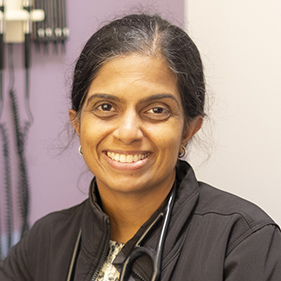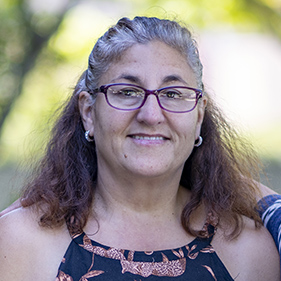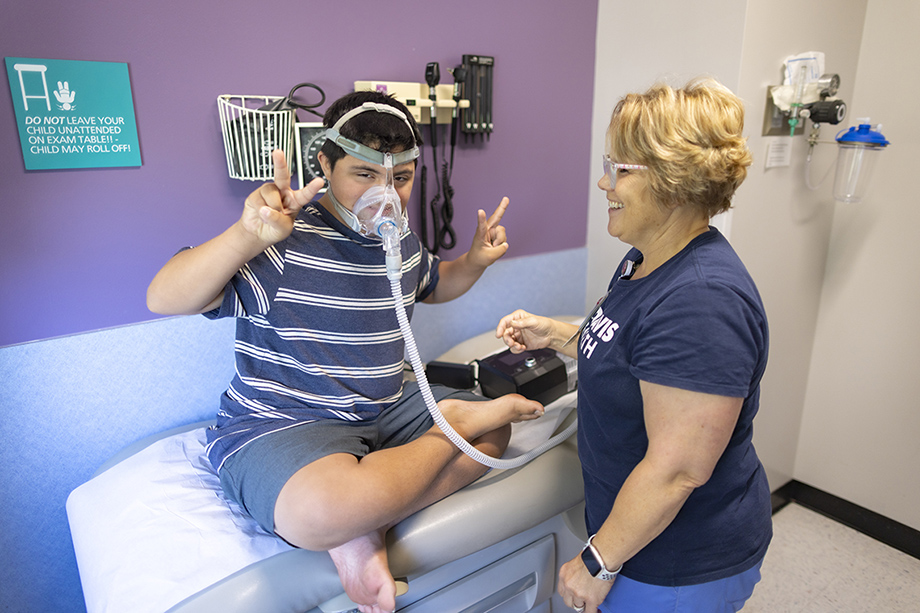
From the time he was a toddler, Emilio Jose Miranda-Vallejo had trouble sleeping. But it wasn't just the usual restlessness some kids experience.
"He was about 2 when we first noticed that he wasn't getting the oxygen he needed," said Shannon Vallejo, Emilio's mother. "We were listening to him and watching him at night. He wouldn't be breathing so we'd wake him up."
In addition, when Emilio was between 3 and 5 years old, he would get sick often.
"We'd be in the hospital and they would notice that his oxygen levels would drop," Shannon said.
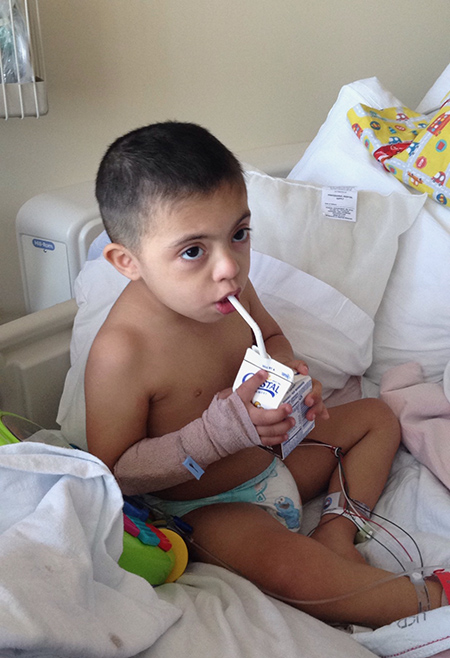
By now the family knew something was wrong and needed to find the right pediatric specialists to care for their son.
They were ultimately referred to UC Davis Children's Hospital, home to a comprehensive pediatric pulmonology and sleep medicine program that offers a variety of services for children with respiratory and sleep conditions.
"We met with pulmonologist Dr. Nandalike and got Emilio's first sleep study done," Shannon said. "We've been working with her and respiratory therapist Audrey ever since. They've been amazing."
Getting answers
The study revealed that Emilio had sleep apnea, a disorder more common in adults that is characterized by repeated pauses in breathing during sleep. These pauses can last for a few seconds to minutes and can occur multiple times per night, disrupting sleep and potentially leading to serious health issues such as heart failure.
Emilio also has Down syndrome. Individuals with Down syndrome are much more likely to have obstructive sleep apnea (OSA) than individuals without Down syndrome. Studies have suggested that 53-76% of children and more than 80% of adults with Down syndrome have OSA, compared to about 2-6% of children and 10% of adults without Down syndrome.
Kiran Nandalike, chief of Pediatric Pulmonology and Sleep Medicine at UC Davis, explained why.
"This happens because of things like enlarged adenoids and tonsils, low airway tone, obesity or thyroid issues," Nandalike said. "Treating it usually requires a team of specialists working together and using different therapies."
The team determined Emilio needed surgery to remove his tonsils and adenoids, the first line of treatment for OSA in children. Thanks to the surgeries, Emilio's sleep apnea improved for many years.
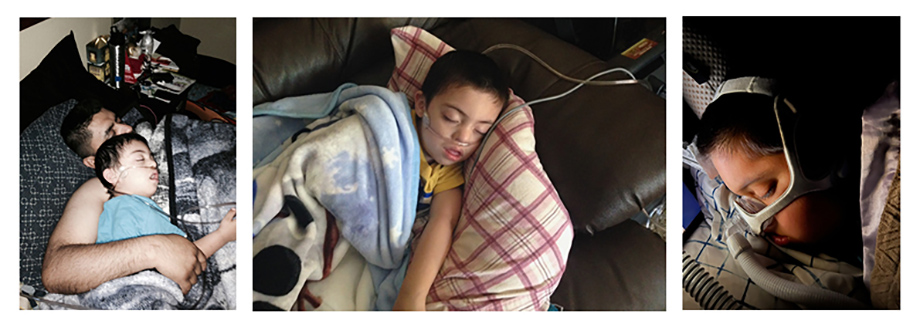
Sleep apnea requires new approach
But in May of 2022, Emilio — 10 years old at that time — once again struggled with his sleep apnea. His tiredness was causing difficulties in the classroom.
"He would be at school and he'd want to sleep. That was really hard," Shannon said. "Plus, when you don't get enough sleep, you're grouchy and grumpy. On top of that, he's predominantly nonverbal and can't express why he's having a hard time. He had aggression and behavior problems as a result."
When his family returned to the Pediatric Pulmonary and Sleep Medicine clinic, his medical team decided that Emilio would benefit from CPAP treatment, or continuous positive airway pressure.
We offer comprehensive CPAP consultations at our pediatric sleep center and have been caring for more than 100 children on this therapy."-Kiran Nandalike, chief of UC Davis Division of Pediatric Pulmonology and Sleep Medicine
A CPAP is a portable machine that delivers gentle air pressure through a tube and into a mask to aid people as they sleep, by keeping their breathing airways open.
"This equipment is often required to treat OSA in children with Down syndrome, but they often struggle to tolerate CPAP therapy," Nandalike said.
Emilio was one of those patients.
"You can't just put something on a kid and expect them to keep it on when they don't understand why it's being put on in the first place," Shannon said. "This was the biggest challenge because he'd wake up in the middle of night and take it off. We worked with the team to get his adjusted."
The team prides itself on helping children adjust to the equipment — which includes a tight-fitting mask held by several headband straps — so they can get a better night's sleep.
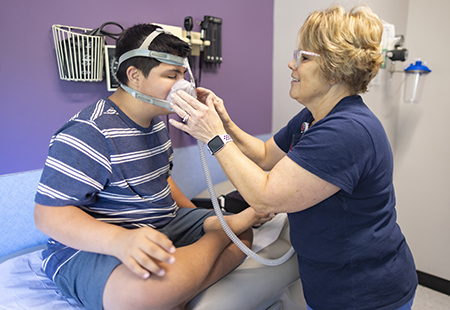
"We offer comprehensive CPAP consultations at our pediatric sleep center and have been caring for more than 100 children on this therapy," Nandalike said.
Nandalike credits respiratory therapist Audrey Chikalla who has significant experience and skills to treat children with respiratory issues. Chikalla also find ways to get children to use the CPAP equipment, which can be uncomfortable for them.
Emilio also benefited from medication.
"Melatonin helped for a little bit. but then we had to get him on another medication," Shannon said. "We had to work to adjust the dose that would keep him asleep because he would wake up every night between midnight and 5 o'clock and would not go back to sleep."
But now, the family has a routine down, and Emilio is sleeping through the night.
"We give him his medication between 9 and 10 p.m. He's pretty good about telling us he's ready for bed, and he puts his CPAP mask on," Shannon said. "But he's a goofball, so he has to be goofy first and then he'll put his mask on. Then it's less than five minutes and he's out. As long as he's still, he keeps it on for the most part."
CPAP success is a team effort
Chikalla and Nandalike attribute Emilio's CPAP success to his family.
I am a UC Davis fan. The staff is so used to working with kids, they're patient and don't get upset if he's having a hard time. They're amazing professionals who really care." -Shannon Vallejo, Emilio's mom
"Emilio and his family have been a delight to work with. They have put in a lot of time, effort and sacrifice to help Emilio become successful with CPAP use," Chikalla said. "Emilio is a sweet kid who is eager to please. He's cheerful and ready to try out a new mask or plan for his CPAP."
Emilio is just one example of the many kids whose lives have improved through the clinic.
"Our CPAP compliance is above the reported average of 50% and we have had remarkable success stories with our patients and families like Emilio," Nandalike said. "It is a heartwarming experience to see children and families being successful with their therapies and achieve restful sleep at night."
This therapy has proven to be a game changer for Emilio and his family.
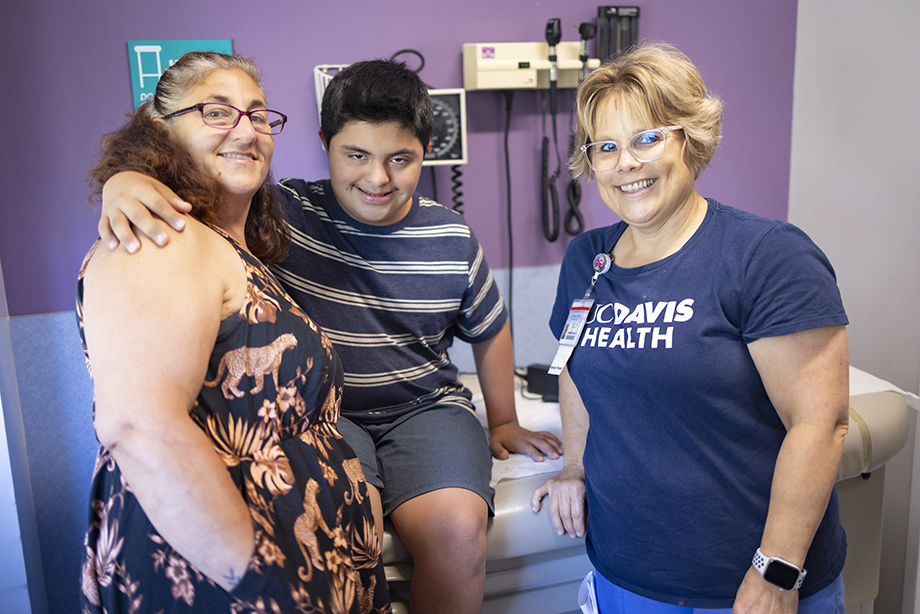
"I am a UC Davis fan. The staff is so used to working with kids, they're patient and don't get upset if he's having a hard time," Shannon said. "They're amazing professionals who really care."
Shannon hopes that by sharing their story, other families can benefit from the program as well.
"Children can start CPAP at any age. We have several infants on CPAP. Some children start CPAP in the preschool years, some as teenagers," Chikalla said. "The driving reason to start CPAP is the impact of the daytime sleepiness symptoms on daily living or the implications of untreated apnea on existing comorbid conditions."
The Miranda-Vallejo family visits the clinic about every six months now, most recently to check on Emilio's latest equipment.
"I'm very blessed to have UC Davis in our lives. They've always been there for him at every turn," Shannon said. "They've helped us maneuver through his health and his life. I absolutely love them."

